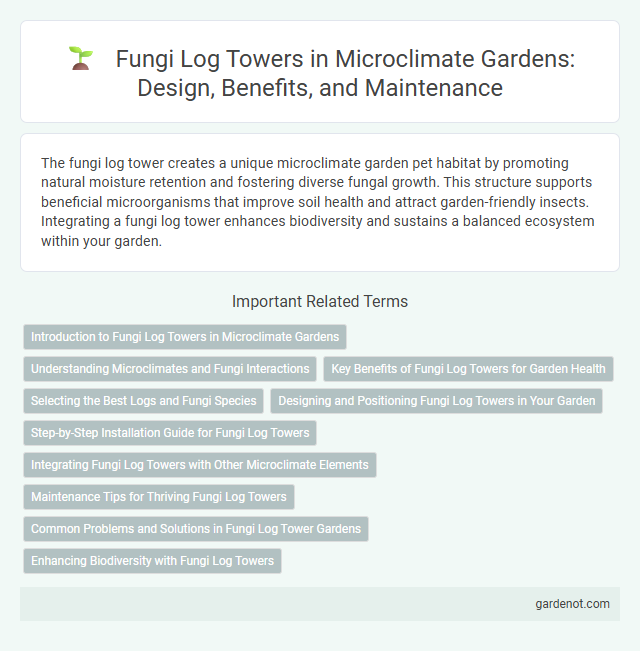The fungi log tower creates a unique microclimate garden pet habitat by promoting natural moisture retention and fostering diverse fungal growth. This structure supports beneficial microorganisms that improve soil health and attract garden-friendly insects. Integrating a fungi log tower enhances biodiversity and sustains a balanced ecosystem within your garden.
Introduction to Fungi Log Towers in Microclimate Gardens
Fungi log towers create a dynamic habitat by decomposing organic matter, enriching soil fertility in microclimate gardens. These vertical structures support diverse fungal species, enhancing nutrient cycling and promoting plant health. Incorporating fungi log towers improves biodiversity and resilience within garden ecosystems.
Understanding Microclimates and Fungi Interactions
Fungi log towers create specialized microclimates by retaining moisture and regulating temperature, fostering unique ecological niches that support diverse fungal species. These structures enhance decomposition rates and nutrient cycling, crucial for maintaining healthy soil ecosystems. Understanding the interplay between fungi and microclimate conditions within log towers reveals their essential role in biodiversity and garden sustainability.
Key Benefits of Fungi Log Towers for Garden Health
Fungi log towers promote soil fertility by breaking down organic matter and recycling nutrients essential for plant growth. Their mycelium networks enhance soil structure and moisture retention, creating a healthier microclimate for garden plants. These towers also support biodiversity by providing habitats for beneficial microorganisms and insects that contribute to garden ecosystem balance.
Selecting the Best Logs and Fungi Species
Selecting the best logs for a fungi log tower involves choosing freshly cut hardwood species like oak, maple, or beech, which offer optimal moisture retention and nutrient content for mushroom cultivation. Ideal fungi species for inoculation include shiitake (Lentinula edodes) and oyster mushrooms (Pleurotus ostreatus), known for their adaptability and robust growth on hardwood substrates. Ensuring logs are free from contaminants and properly seasoned enhances mycelium colonization, promoting a productive and sustainable microclimate garden ecosystem.
Designing and Positioning Fungi Log Towers in Your Garden
Designing and positioning fungi log towers in your garden requires selecting a shaded, moist area with rich organic soil to support fungal growth and biodiversity. Arrange logs vertically or at slight angles to maximize surface area exposure and ensure proper air circulation, which encourages mycelium colonization and spore dispersal. Incorporating a variety of hardwood species such as oak, maple, and beech promotes diverse fungi species development, enhancing the garden's microclimate and ecological balance.
Step-by-Step Installation Guide for Fungi Log Towers
Select hardwood logs such as oak or maple, cut into 3-4 foot sections, and drill holes approximately 1-2 inches deep and spaced 4-6 inches apart to inoculate with mushroom spawn. Stack the logs vertically or in a tower formation on a shaded, moist area, ensuring adequate airflow and consistent humidity to foster fungal growth. Water the log tower regularly and protect it from excessive sunlight and wind to maintain optimal conditions for mycelium colonization and mushroom fruiting.
Integrating Fungi Log Towers with Other Microclimate Elements
Fungi log towers thrive when integrated with shaded areas, moisture-retentive mulch, and native understory plants that maintain humidity and soil health. Positioning these towers near decaying wood piles and leaf litter encourages spore dispersal and nutrient cycling within the microclimate garden. Combining fungi log towers with companion plants such as ferns and mosses enhances biodiversity and creates a balanced ecosystem supporting decomposition and soil fertility.
Maintenance Tips for Thriving Fungi Log Towers
Regularly monitor moisture levels in the fungi log tower, ensuring the logs remain damp but not waterlogged to promote optimal fungal growth. Position the tower in a shaded, humid microclimate garden area to maintain consistent environmental conditions and prevent drying out. Remove any decaying or moldy sections promptly to prevent detrimental fungal competition and encourage healthy development.
Common Problems and Solutions in Fungi Log Tower Gardens
Common problems in fungi log tower gardens include contamination by competing molds, insufficient moisture levels, and poor air circulation. Prevent contamination by sterilizing logs before inoculation and maintaining consistent humidity around 85-95% to promote healthy mycelium growth. Improve airflow without causing dryness, and monitor for pest infestations such as insects or slugs to ensure optimal fungi development.
Enhancing Biodiversity with Fungi Log Towers
Fungi log towers play a crucial role in enhancing biodiversity by creating a habitat for various fungal species that support ecosystem health. These structures promote decomposition processes, enriching soil nutrients and fostering a diverse microhabitat for insects, mosses, and other microorganisms. Integrating fungi log towers in microclimate gardens boosts fungal colonization, which stabilizes moisture levels and supports plant growth through symbiotic relationships.
Fungi log tower Infographic

 gardenot.com
gardenot.com